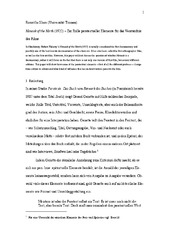| dc.contributor.author | Skare, Roswitha | |
| dc.date.accessioned | 2010-03-09T13:37:41Z | |
| dc.date.available | 2010-03-09T13:37:41Z | |
| dc.date.issued | 2010 | |
| dc.description.abstract | In film history Robert Flaherty’s Nanook of the North (1922) is usually considered the first documentary and possibly one of the best known documentaries of the silent era. It has also been called the first ethnographic film, as well as the first art film. However, this paper will not discuss the question of whether Nanook is a
documentary, rather it will focus on the fact that there is not only one version of this film, but several different editions. This paper will show how some of the paratextual elements – first of all the different prefaces – change from edition to edition and what kind of influence this has on how viewers perceive the film. | en |
| dc.description | This is the accepted version (final draft post review), reprinted with permission. | en |
| dc.format.extent | 82856 bytes | |
| dc.format.extent | 37569090 bytes | |
| dc.format.mimetype | application/pdf | |
| dc.format.mimetype | application/pdf | |
| dc.identifier.citation | Neohelicon, vol 37 nr 1, 2010 | en |
| dc.identifier.cristinID | FRIDAID 494240 | |
| dc.identifier.issn | 0324-4652 | |
| dc.identifier.uri | https://hdl.handle.net/10037/2432 | |
| dc.identifier.urn | URN:NBN:no-uit_munin_2182 | |
| dc.language.iso | ger | en |
| dc.publisher | Akademiai Kiadó | en |
| dc.publisher | Springer Verlag | en |
| dc.rights.accessRights | openAccess | |
| dc.subject | VDP::Humaniora: 000::Film- og teatervitenskap: 170::Filmvitenskap: 171 | en |
| dc.subject | VDP::Humanities: 000::Movie and drama: 170::Movie science: 171 | en |
| dc.title | Nanook of the North (1922) – Zur Rolle paratextueller Elemente für das Verständnis des Films | en |
| dc.type | Journal article | en |
| dc.type | Tidsskriftartikkel | en |
| dc.type | Peer reviewed | en |


 English
English norsk
norsk